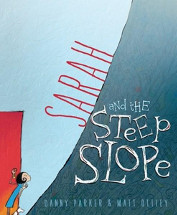Sarah and the Steep Slope by Danny Parker and Matt Ottley

Little Hare, 2017. ISBN 9781742974675
When Sarah opened her door one morning she was confronted by it. A
steep slope. Blocking out the sun and casting a shadow across
everything. Rising in front her like an insurmountable and
impenetrable barrier. And so it proved to be.
Prodding and pushing didn't move it, surprising it didn't shake it
and trying to sneak around it was hopeless. And when she tried to
climb it, even with her climbing shoes, she got halfway and then
slid all the way back down. How was she going to see her friends?
Nothing worked - even ignoring it didn't make it go away and neither
did the help of the slope doctor so he left clutching a lot of notes
for Sarah's friends and going out the door to a flat, sunlit
landscape. Next day her friends visited her and they didn't see the
steep slope either. They stayed and played all day long. And the
next day . . .
This is a sophisticated picture book for older readers who will
appreciate its symbolism as Sarah tries to negotiate the steep slope
that is only visible to her. Younger readers who are still at a very
literal stage of development may not understand that the slope
exists only in Sarah's mind and that it is a representation of a
problem that she perceives to have no solution.
If used in a class situation, students may make suggestions about
the slope that is facing Sarah and be willing to share the "slopes"
they have had to navigate - physical, academic, mental and emotional
- and how they found their way, while others with slopes in front of
them still may draw comfort and even hope that they are not alone
and that there is a pathway they can follow. We are all faced with
"slopes' as we live and learn - some steeper than others but without
them there is no progress in life - and part of the success of
climbing them lies in being able to acknowledge and analyse the
issue, break it into small steps, develop strategies to tackle each
step, understand that others are willing and able to help and it is
no shame to ask them, believe success is possible and engage in
positive self-talk.
This is a story about the power of friendship, of having the courage
to take the next step forward, of being resilient and acknowledging
we are part of a village that we can seek support from and that
there is always help and hope. The absence of Sarah's family in her
solution and her reaching out to a doctor rather than a parent
suggest that sometimes the issue is within the family or it is not
something the child feels comfortable talking about with a family
member for a range of reasons, giving the reader the approval that
it is okay to seek advice and assistance beyond the traditional
helpers used as they have grown up without feeling guilty that they
have betrayed anyone or hurt their feelings.
Apart from the concepts of symbolism, similes and metaphors and all
that technical English language stuff, this is an important book in
the mindfulness collection as we finally start to acknowledge the
mental health issues for even the youngest children and help them
develop the strategies and skills that will enable and empower them.
Those are the important lessons teachers, and I use the word in its
broadest sense, teach.
Barbara Braxton